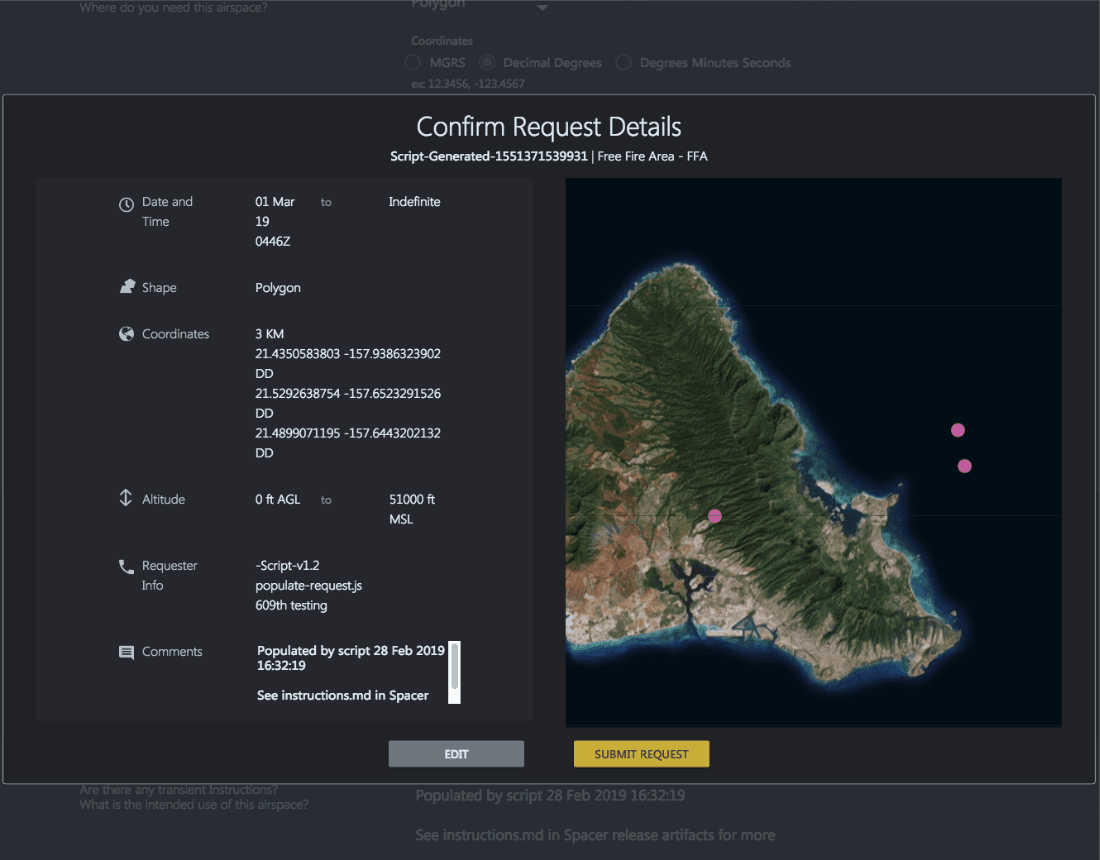Category /
Presentation
airspace provisioning for US Air Force mission planning
airspace provisioning for US Air Force mission planning
airspace provisioning for US Air Force mission planning
I launched an MVP for US Air Force mission planners to manage 4-dimensional airspace library
Conducted 20+ user interviews across multiple Air Operations Centers to understand and map the current processes for mission planning and airspace management
Crafted roadmap to digitize a previously manual, error-prone airspace request process
Implemented geospatial map visualization to enhance situational awareness
Devised automated system suggestions to manage location, altitude, and time conflicts - significantly decreasing mission planning time and reducing overall airspace conflicts
users:
air force command and control mission planners requesting airspace
airspace managers provisioning airspace
problems:
planes should not collide mid-air, and certain complicated missions require precise airspace planning to ensure certain planes fly in the right places at the right times (and altitudes).
people who request airspaces don’t have a ton of visibility into existing airspace libraries and often don’t specialize in airspace knowledge, leading to messy and incomplete requests.
airspace managers need an easy way to deconflict airspaces that overlap in location, altitude and time.
goals:
standardize airspace request formats to include all necessary information
give airspace requestors a chance to deconflict their own airspace requests systematically
give airspace managers an easier way to manage more complex airspace conflicts
airspace requestor outcomes:
fill out complete airspace requests digitally
be alerted to potential conflicts, and be given tools to troubleshoot on their own
airspace manager outcomes:
receive and review pending airspace requests
understand how to troubleshoot issues on my own + more easily locate the affected parties I need to talk to when I need to fix complex airspace conflicts
lessons learned:
sometimes your MVP looks nothing like your intended future product
patience is needed when working with any government organization (concerning stakeholder management and user access, in particular)
I launched an MVP for US Air Force mission planners to manage 4-dimensional airspace library
Conducted 20+ user interviews across multiple Air Operations Centers to understand and map the current processes for mission planning and airspace management
Crafted roadmap to digitize a previously manual, error-prone airspace request process
Implemented geospatial map visualization to enhance situational awareness
Devised automated system suggestions to manage location, altitude, and time conflicts - significantly decreasing mission planning time and reducing overall airspace conflicts
users:
air force command and control mission planners requesting airspace
airspace managers provisioning airspace
problems:
planes should not collide mid-air, and certain complicated missions require precise airspace planning to ensure certain planes fly in the right places at the right times (and altitudes).
people who request airspaces don’t have a ton of visibility into existing airspace libraries and often don’t specialize in airspace knowledge, leading to messy and incomplete requests.
airspace managers need an easy way to deconflict airspaces that overlap in location, altitude and time.
goals:
standardize airspace request formats to include all necessary information
give airspace requestors a chance to deconflict their own airspace requests systematically
give airspace managers an easier way to manage more complex airspace conflicts
airspace requestor outcomes:
fill out complete airspace requests digitally
be alerted to potential conflicts, and be given tools to troubleshoot on their own
airspace manager outcomes:
receive and review pending airspace requests
understand how to troubleshoot issues on my own + more easily locate the affected parties I need to talk to when I need to fix complex airspace conflicts
lessons learned:
sometimes your MVP looks nothing like your intended future product
patience is needed when working with any government organization (concerning stakeholder management and user access, in particular)
I launched an MVP for US Air Force mission planners to manage 4-dimensional airspace library
Conducted 20+ user interviews across multiple Air Operations Centers to understand and map the current processes for mission planning and airspace management
Crafted roadmap to digitize a previously manual, error-prone airspace request process
Implemented geospatial map visualization to enhance situational awareness
Devised automated system suggestions to manage location, altitude, and time conflicts - significantly decreasing mission planning time and reducing overall airspace conflicts
users:
air force command and control mission planners requesting airspace
airspace managers provisioning airspace
problems:
planes should not collide mid-air, and certain complicated missions require precise airspace planning to ensure certain planes fly in the right places at the right times (and altitudes).
people who request airspaces don’t have a ton of visibility into existing airspace libraries and often don’t specialize in airspace knowledge, leading to messy and incomplete requests.
airspace managers need an easy way to deconflict airspaces that overlap in location, altitude and time.
goals:
standardize airspace request formats to include all necessary information
give airspace requestors a chance to deconflict their own airspace requests systematically
give airspace managers an easier way to manage more complex airspace conflicts
airspace requestor outcomes:
fill out complete airspace requests digitally
be alerted to potential conflicts, and be given tools to troubleshoot on their own
airspace manager outcomes:
receive and review pending airspace requests
understand how to troubleshoot issues on my own + more easily locate the affected parties I need to talk to when I need to fix complex airspace conflicts
lessons learned:
sometimes your MVP looks nothing like your intended future product
patience is needed when working with any government organization (concerning stakeholder management and user access, in particular)
Year:
2018
Year:
2018
Year:
2018
Role:
Product Management Consultant
Role:
Product Management Consultant
Role:
Product Management Consultant


















selected works
Other interesting work

engaging UX for B-seeking companies that prioritize people and planet
2020-2021

engaging UX for B-seeking companies that prioritize people and planet
2020-2021

engaging UX for B-seeking companies that prioritize people and planet
2020-2021

startup design sprint: leftover food donation pickup
2017

startup design sprint: leftover food donation pickup
2017

startup design sprint: leftover food donation pickup
2017
